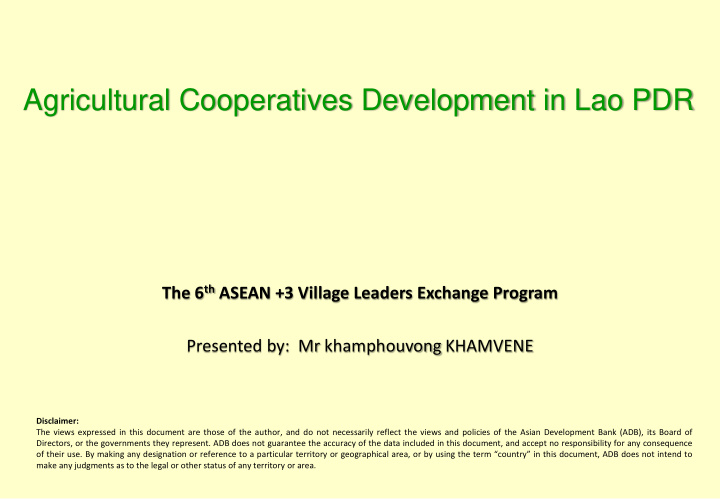



Agricultural Cooperatives Development in Lao PDR The 6 th ASEAN +3 Village Leaders Exchange Program Presented by: Mr khamphouvong KHAMVENE Disclaimer: The views expressed in this document are those of the author, and do not necessarily reflect the views and policies of the Asian Development Bank (ADB), its Board of Directors, or the governments they represent. ADB does not guarantee the accuracy of the data included in this document, and accept no responsibility for any consequence of their use. By making any designation or reference to a particular territory or geographical area, or by using the term “country” in this document, ADB does not intend to make any judgments as to the legal or other status of any territory or area.
Contents I. Policy and Strategy for Promoting ACs in Laos II. Institutions and database of the ACs in AMS III. National programs/initiatives for ACs development IV. Challenges in ACs development V. Recommendation for regional Cooperation 2
I. Policy and Strategy for Promoting ACs in Laos • Prime Minister of the Lao PDR decrees no. 136/PM (Decree on Cooperative), 05 March 2010; • Agreement of the Minister Regarding Agricultural Cooperatives no. 2983/MAF, 25 September 2014; • In reference to the proposal 1954/DAEC, 16 June 2014 of the Department of Agriculture Extension and Cooperatives • The National Scio-economic Development Plan 2015- 2020; • Other legal documents under the Law on AC to be formulated. 3
Support Mechanism for Acs 1. At National Level: ❖ The Rural Development and Cooperatives Department Local Level: ❖ 18 Provincial Agricultural and Forestry Office (PAFOs) ❖ 148 Districts Agricultural and Forestry Office (DAFOs) 4
II. Institutions and database of the ACs DRDC’s main duties ❖ Support and strengthen organizations of groups and farm for commodity production and food security, promote contract farming moving forward to establish new agricultural cooperatives enabling development of a stronger economy at the grassroots level ❖ Establish and improve technical service centers and extension staffs at all levels as: national, provincial, district and village 5
❖ Establishment a system to dissemination and provide information services on production techniques, processing and marketing. ❖ Promote sustainable development of coops operating agribusiness and provision of services to access credit, access to domestic and international market and exchange experiences within country and abroad. ❖ Develop a mechanism to cooperate with research institutes, other departments and development partners to mobilize resources and technical supports for development and implementation of program and projects on agricultural extension, group and cooperatives development. ❖ coordinate with development partners within and outside country for development of ACs in Laos 6
Achievement of DRDC • Establish of Farmers Group almost 2,720 while 1,050 are crops plantation and 1,670 animal feeding and fishery groups with more than 50,000 members • Areas 16,589ha, capital 7,500,940,000LAK(1M$) • Established 189 TSCs
Activities Exhibition
III. National programs/initiatives for ACs development ❖ National programs • Rural Development and Cooperatives Department,MAF Agriculture Development Fund (Both FGs and ACs) • PAFOs, PICOs(Provincial Industry and Commerce Office) ❖ External programs • Korean Rural Economic Institute (KREI) on ACs models • German Cooperative and Raifeisen Federation, DGRV 2013- 2017, (Regulation on ACs and Legal framework) • Others as: INGOs etc… 9
❖ Capacity building for ACs • TOT on the concepts of Agricultural Cooperatives • TOT on specific topics related to agricultural cooperatives • Overseas trainings • Conduct training courses • Organize workshops and study visits ❖ ACs business network • Organize Agricultural Cooperative Business Forums; • Organize farm products and agricultural service exhibitions • Etc … 10
IV. Challenges in ACs development • Inadequate legal frameworks and policies to promote ACs; • Inadequate education and training materials for ACs • Limited human resources in the field of ACs • Lack of training center for ACs • Most ACs have low capacity in leadership and management, financial management, marketing and business plans; • Financial institutions have not yet provided loan to ACs and loan have high interest rate. • Most ACs lack of physical infrastructures e.g. post-harvest facilities, processing and marketing facilities. • Management of ACs have low education level and so old. 11
Strategic Plan to Promote ACs • Develop policy and strategy on promoting ACs; • Continue to formulate legal framework under AC law; • Develop human resources; • Set up and Manage ACs Development Fund; • Establish the national training center for ACs; • Build up the capacity of ACs promoters; • Develop education and training materials for ACs • Develop and introduce models for ACs to apply to promote their businesses and to comply with the Law on ACs; 12
Recommended for regional cooperation 1. Legal framework development for ACs (policy or related documents with ACs) 2. Development of Education and Training Materials to strengthen the capacity of ACs 3. Capacity Building Program for ACs through trainings, workshops, exchange visits and others 4. Joint project on promoting ACs 5. Promote Agricultural Cooperative Business Network 6. Establish of ACs models in the country 13
Thank you
Recommend
More recommend